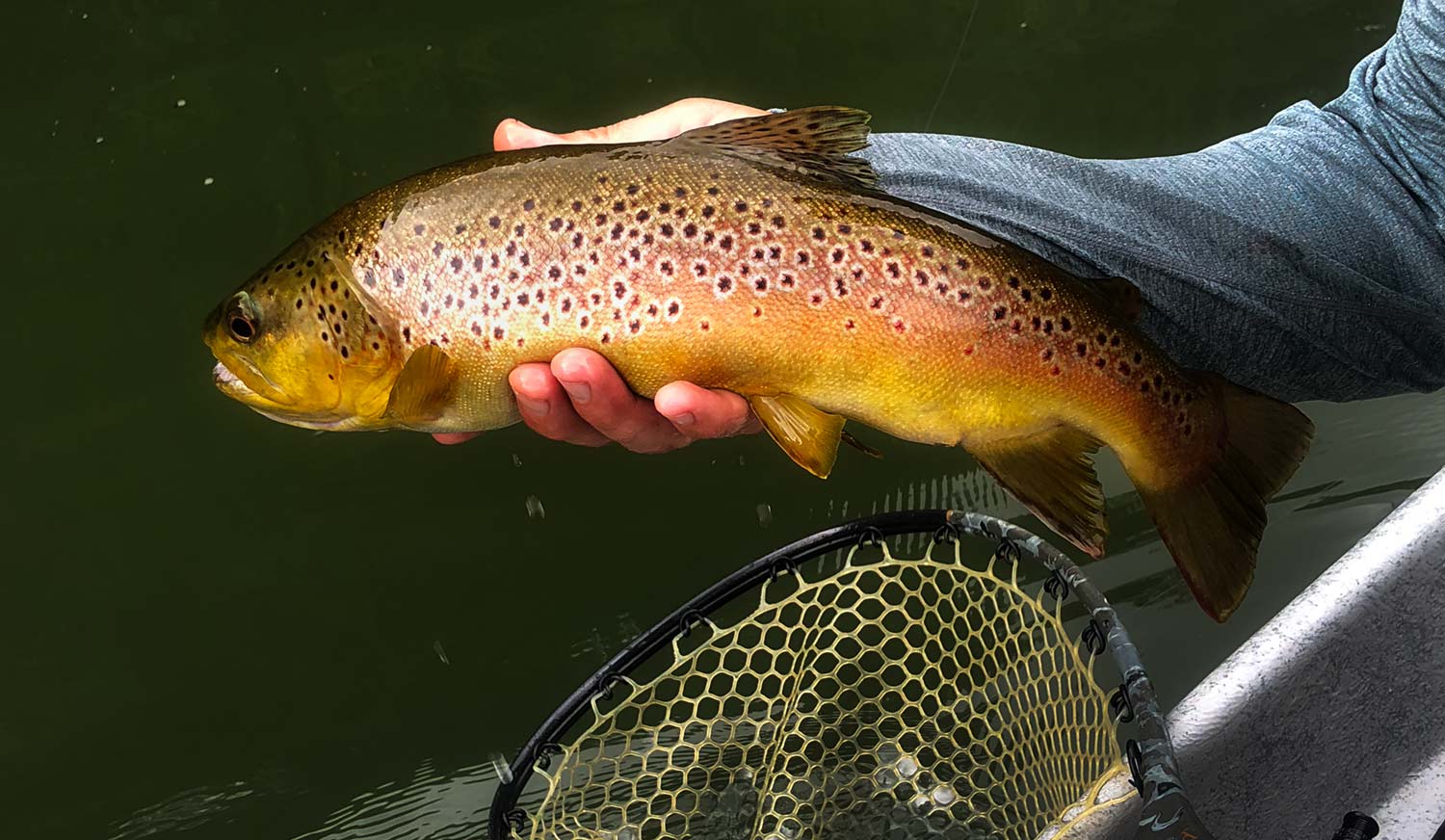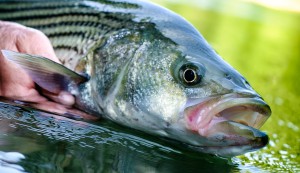By Louis Cahill
“The last thing I expected to see was this big male brown trout becoming food.”
By this time, in any normal year, I am done with trout fishing. Not that I don’t enjoy it but water temperatures here in the South reach near-lethal levels in the summer and it doesn’t feel responsible to target trout under those conditions. Fortunately, a couple of my local rivers offer me a stellar alternative.
As local lakes heat up, striped bass move into the rivers for cooler water and, I suppose, to satisfy their anadromous instincts. These fish are big, strong fighters, and difficult to target with a fly. Pretty much everything I like in a fish. Once June rolls around, I spend most of my local fishing time focusing on them.
The problem is, this has been anything but a normal year. My local river, the Chattahoochee, has been a raging torrent of mud since early spring. Heavy rains, nearly every day, have kept the river un-fishable for almost the entire season. By last week, I desperately needed some time in my drift boat so I planned a quick trip to a favorite Tennessee tailwater. My buddies Geoff Murphy and S.C.O.F. editor Dave Grossman joined me for a two-day float.
Repair work on the downstream dam have the river on a low flow and rain has colored the water. Conditions are far from perfect but I’m excited to target some of the big brown trout that inhabit these waters. I showed up with a pretty anemic selection of dry flies and nymphs and two boxes full of big streamers. I’m ready for a challenge.
Geoff and Dave have been picking up some fish on beetle patterns and suffers but I haven’t had so much as a look at my streamer. Geoff gets a rainbow in the head of a big deep pool and quickly releases it. As soon as the fish hits the water a commotion starts.
A large dark form comes up out of the deep hole and runs the little rainbow down.
It’s a big striped bass. It stuns the rainbow with its first strike and then plays with it, like a dog with a toy. The big striper busts the surface again and again, toying with the trout before finally inhaling it. It’s the kind of display I expect to see in saltwater, not a trout stream.
Stripers have been moving farther and farther up river since the lake was drawn down, Dave explains. They have been seen as far upstream as the next dam. This news gives me a new mission. If I can’t target my stripers at home, I’d sure like to catch one here. We row back to the top of the pool and anchor up to let the fish re-set.
In about the time it takes to drink a beer and tie on a big white streamer, the big predator forgot all about us and started busting the surface again. Geoff rows downstream while Dave and I throw meat for all we we’re worth. If that big boy is hungry, we’re going to offer him a meal. About halfway through the pool, my line comes tight and throbs with a big head shake.
“There he is!” I growl.
When the fish comes to the surface and rolls, I’m expecting a bright silver flank and jagged black stripes but what I see is deep brown with red spots. It’s a nice male brown, about eighteen inches. A great fish but less than half the fish I was expecting. Still, I’ll never complain about a big brown trout. I’m happy to have him. Dave gets the net ready as I bring him to the boat. I’m rigged for striper, so I can land this fish with some authority. As I lift him from the green depths, a big dark form materializes like a Klingon Bird of Prey uncloaking. Our friend in the striped pajamas is back.
The last thing I expected to see was this big male brown trout becoming food but it’s about to happen. The striper is about twenty pounds. There’s no doubt he’s the boss of this pool. He’s taking a minute to size up the brown trout like you might take a minute to consider ordering that steak that’s free if you finish it in a sitting. No one is sure what will happen next, especially the trout, who is getting more than a bit nervous.
“Get your rod!” I yell to Dave and he drops the net.
I let the brown run, but not too far. The last thing I want is to see this great fish get malled but he’s still pretty green and I’d really like to see Dave get this striper. The brown is now an unwitting participant in a team effort to see who the real predator is. I’m taking a risk, right or wrong. I keep the net ready and stop my fish’s run.
Dave puts a huge streamer between the two fish and strips. No reaction from the striper. He noses right up to the brown and Dave slaps one on his nose. He doesn’t like that and sinks out of sight. It’s odd, how deliberate and considered his actions seem. I’ve seen a lot of hooked fish attacked, but I’ve never seen the aggressor swim up and look his prey in the eye like this. It seems straight up thuggish.
I bring the brown back to the boat to land and as soon as we’re ready for the net, our friend is back. This time I keep my fish within reach. I want to be able to scoop him if things go badly. The bass still seems like he’s on the fence so we go with it. Dave puts the fly in from of him again and he sinks back to the bottom. As I make the move to scoop the trout, the striper comes back a third time. This time I go ahead and net the fish. I’m not going to exhaust him for the sake of this bass.
The brown is still in great shape. Geoff snaps a quick photo and I release him into some woody cover where he’ll be safe from the striper. We row back up and work the pool again but all of the drama has shut things down. I’ve seen enough to believe. I’m striper fishing the rest of the day.
It’s pretty cool seeing a scene like this play out, but it does make me concerned for this health of the river. That striper is not alone. When you find one, you’ve found a pod. If these tough predators are coming after eighteen-inch fish, the smaller fish are taking a beating.
Unfortunately, that’s what happens when we start to tinker with an ecosystem. As much as I love to trout fish on this great tailwater, the trout are not necessarily the good-guys in this story themselves. They replaced the native smallmouth who lived here before the TVA dam was built in the 1940s. Now that the TVA has made changes to the river again, a new species finds itself completing for dominance.
It’s a tough situation with no clear right or wrong. Fish are just being fish, and dams must be fixed. Whatever happens on our local rivers, I’ll be out there targeting the biggest, toughest fish in the system, whatever species that might be. While I’m doing it, I’ll try to have as little negative impact on the fish as possible. Not because I’m some purist, or on my high-horse about anything, but because I love these rivers and I want to be able to catch fish there when I’m so old it’s bad idea, and I want the anglers who come after me to have the same chance.
What are your thoughts on the changing fisheries in the Southeast? Let us know in the comments.
Louis Cahill Gink & Gasoline www.ginkandgasoline.com hookups@ginkandgasoline.com
 Sign Up For Our Weekly Newsletter!
Sign Up For Our Weekly Newsletter!



The trout weren’t natural to begin with. Also who’s to say the striped bass didn’t always do that? Meaning they have always headed for the upper reaches or the dam to feed on the bounty that gets haulted and confined because of the dam. Guides have always targeted striped bass behind dams on inland and coastal waters. Now…. go do that same thing at night and see what happens.
Jon
Fisheries are changing all over the US and even Canada. My take is that we are entering an era of instability with populations increasing or crashing, new species showing up and changing relationships among game fish, bait, and even invertebrate food sources. All this with increasing pressure from development and a changing climate. Who knows what the ‘right’ thing to do is?
Agencies are going to have a hell of a time trying to keep up.
Great article. Recognize though that most of our waters in the continental US and probably Canada and Mexico as well, are not “natural” in the sense of their aquatic community. During the 1800s as new lands were opened and America was being settled, game fish were stocked everywhere to enhance the fishery. Thankfully, most stocking efforts probably failed. I’ve included a link to an article on this for your reading pleasure.
http://www.webpages.uidaho.edu/css496/secure/Readings/WFishStockingHistory.pdf